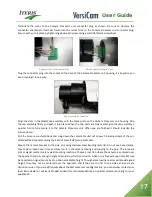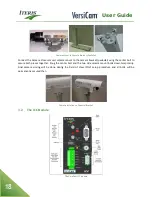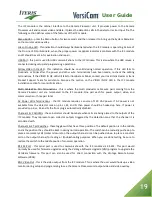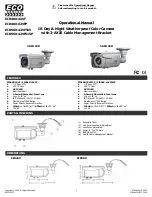
User Guide
28
Proper Mounting Height – The camera should be mounted at approximately 30 feet for optimal system
performance. For lower mountings, like a mast arm mount, a suitable camera extension bracket should be
used to increase the camera mounting height to a more workable elevation. A camera mounting height of 25
feet or more can usually be obtained by using an extension bracket. Low mounting heights can result in
reduced system performance and vehicle occlusion.
Important:
How far can the camera typically see out at a mounting height of 30 feet?
The basic formula for LEVEL ground is for every one foot of height you can see out 10 feet. So, on
level ground, at a 30 foot mounting height, you should be able to get accurate detection as far as
three hundred feet. This measurement is from the camera mounting location, not from the
intersection stop bar area.
Note:
The importance of camera centering versus camera height deserves some further discussion.
It must be recognized how important centering the camera is to optimal system performance. In
many cases centering the camera is more important than getting an additional five feet of height.
For instance, when dealing with a short luminaire arm on a very wide roadway, it might be a better
choice to mount the camera on the mast arm with a suitable extension bracket. With the right
extension bracket you should be able to achieve a mounting height of about 25 feet. While this is less
than the 30 feet you would achieve with a luminaire mounting, the ability to center the camera over
the roadway in this example makes the mast arm with a six foot extension bracket the better choice.
The luminaire mounting would get the camera up a little higher, but because the luminaire arm is
short and the roadway is wide, this would place the camera way off to one side and would adversely
impact the field of view. Remember there are two considerations for camera mounting (height and
centering) and they both must be carefully evaluated.
Maintain a Proper Camera Angle – The physical camera adjustments are done by adjusting the camera
bracket mounting bolts to set the mechanical camera pan and tilt after the camera bracket has been
mounted to the arm or pole. The camera should always be tilted slightly downward and should never be flat
or beyond horizontal. When could a camera be in danger of being beyond horizontal? When the camera is
aiming uphill on a steep grade. The distance the camera can look out is significantly reduced on approaches
with a steep uphill grade.
Summary of Contents for VersiCam
Page 1: ...Part Number 493432201 Rev F ...
Page 13: ...User Guide 13 2 1 Menu Tree ...
Page 30: ...User Guide 30 ...
Page 77: ...User Guide 77 10 TECHNICAL INFORMATION IMSA 39 2 40 2 Cable ...
Page 79: ...User Guide 79 VersiCam Specification Sheet ...
Page 80: ...User Guide 80 Phase Information ...
Page 81: ...User Guide 81 Detector Rack Configurations ...
Page 83: ...User Guide 83 ...
Page 84: ...1700 Carnegie Avenue Santa Ana CA 92705 Phone 949 270 9400 Fax 949 270 9401 ...
















































